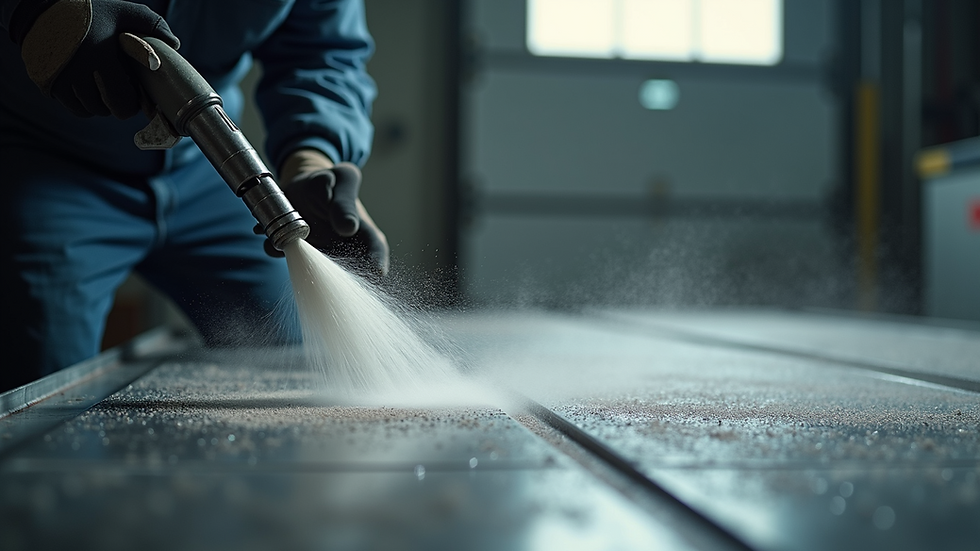Importance of Surface Preparation for Coating
- Mound House Powder Coating

- Nov 2
- 4 min read
When it comes to achieving a flawless, long-lasting finish on metal surfaces, the secret lies beneath the topcoat. I’ve seen countless projects where the final look and durability hinged entirely on the quality of the surface preparation. Whether you’re protecting industrial equipment, enhancing architectural metalwork, or restoring automotive parts, understanding the importance of surface prep is non-negotiable. It’s the foundation that supports every layer of coating, ensuring adhesion, corrosion resistance, and aesthetic appeal.
In this post, I’ll walk you through why surface preparation is critical, the best practices to follow, and how it directly impacts the lifespan and performance of your coatings. Let’s dive in.
Why the Importance of Surface Prep Cannot Be Overstated
Surface preparation is the first and most crucial step in any coating process. It involves cleaning, removing contaminants, and creating the ideal texture for the coating to bond effectively. Skipping or rushing this step can lead to premature coating failure, peeling, rust, and costly repairs.
Here’s why surface prep matters so much:
Adhesion: Coatings need a clean, roughened surface to grip onto. Without proper prep, the coating can lift or flake off.
Corrosion Protection: Removing rust, mill scale, and old paint prevents corrosion from spreading underneath the new coating.
Smooth Finish: Proper prep eliminates imperfections that would otherwise show through the coating.
Longevity: A well-prepared surface extends the life of the coating, reducing maintenance frequency and costs.
For example, in industrial settings where metal structures face harsh environments, a poorly prepared surface can lead to rapid corrosion and structural failure. On the other hand, meticulous prep combined with high-quality coatings can protect assets for decades.

Best Practices for Effective Surface Preparation
Achieving the perfect surface for coating requires a systematic approach. Here are the key steps I recommend:
Cleaning: Remove oils, grease, dirt, and other contaminants using solvents or detergents.
Rust and Scale Removal: Use mechanical methods like wire brushing, grinding, or abrasive blasting to eliminate rust and mill scale.
Surface Profiling: Create a rough texture that promotes adhesion. Abrasive blasting is the gold standard here.
Drying: Ensure the surface is completely dry before applying any coating.
Inspection: Check for any remaining contaminants or defects that could compromise the coating.
One of the most effective methods I’ve come across is abrasive blasting, which not only cleans but also profiles the surface. If you want to learn more about this technique, check out this detailed guide on surface preparation for coating.
In addition, selecting the right preparation method depends on the substrate, environment, and coating type. For instance, delicate parts may require chemical cleaning instead of abrasive blasting to avoid damage.

What is the 80 20 Rule for Coating?
The 80 20 rule in coating emphasizes that 80% of coating success depends on surface preparation, while only 20% depends on the coating material itself. This principle highlights how critical prep is compared to the choice of paint or powder coating.
Why does this rule hold true? Because no matter how advanced or expensive a coating is, it cannot perform well if it doesn’t adhere properly. Surface contaminants, rust, or poor texture will cause the coating to fail prematurely.
This rule also guides resource allocation. Investing time and effort upfront in surface prep saves money and headaches down the line. It’s a classic case of “do it right the first time.”
Common Surface Preparation Techniques and When to Use Them
Different projects require different prep methods. Here’s a quick overview of the most common techniques and their ideal applications:
Solvent Cleaning: Best for removing oils and grease on relatively clean surfaces.
Hand or Power Tool Cleaning: Suitable for small areas or light rust removal.
Abrasive Blasting: Ideal for heavy rust, mill scale, and creating a profile on large surfaces.
Chemical Cleaning: Used when mechanical methods are impractical or could damage the substrate.
Vacuum Blasting: A dust-free option for sensitive environments.
For example, in powder coating applications, abrasive blasting is often the preferred method because it ensures the coating adheres strongly and evenly. On the other hand, delicate aerospace components might require chemical cleaning to avoid surface damage.
Understanding the right technique for your project ensures you get the best results without unnecessary costs or risks.
How Proper Surface Prep Enhances Durability and Appearance
The benefits of thorough surface preparation extend beyond just adhesion. It directly influences the coating’s resistance to environmental factors like moisture, UV rays, and chemicals.
Here’s how:
Prevents Underfilm Corrosion: By removing rust and contaminants, you stop corrosion from spreading beneath the coating.
Improves Coating Uniformity: A clean, profiled surface allows coatings to spread evenly, avoiding thin spots or bubbles.
Enhances Color and Gloss: Proper prep ensures the coating’s true color and finish shine through without imperfections.
Reduces Maintenance: Durable coatings mean fewer touch-ups and longer intervals between recoating.
For businesses and industries relying on metal finishes, this translates to lower downtime, reduced repair costs, and a professional appearance that lasts.
Final Thoughts on Mastering Surface Preparation
Mastering surface preparation is the key to unlocking the full potential of any coating project. It’s not just a step in the process - it’s the foundation of success. By investing in proper cleaning, rust removal, and profiling, you ensure your coatings perform beautifully and stand the test of time.
If you want your metal finishes to be both stunning and durable, never underestimate the power of surface prep. Whether you’re working on industrial equipment, architectural elements, or custom projects, this step will save you money, time, and frustration.
For expert assistance and specialized services in Northern Nevada, consider partnering with professionals who understand the nuances of surface preparation and coating application. Their expertise can elevate your project from good to exceptional.
Remember, a great finish starts with a great surface. Take the time to prepare it right, and your coatings will thank you for years to come.




Comments